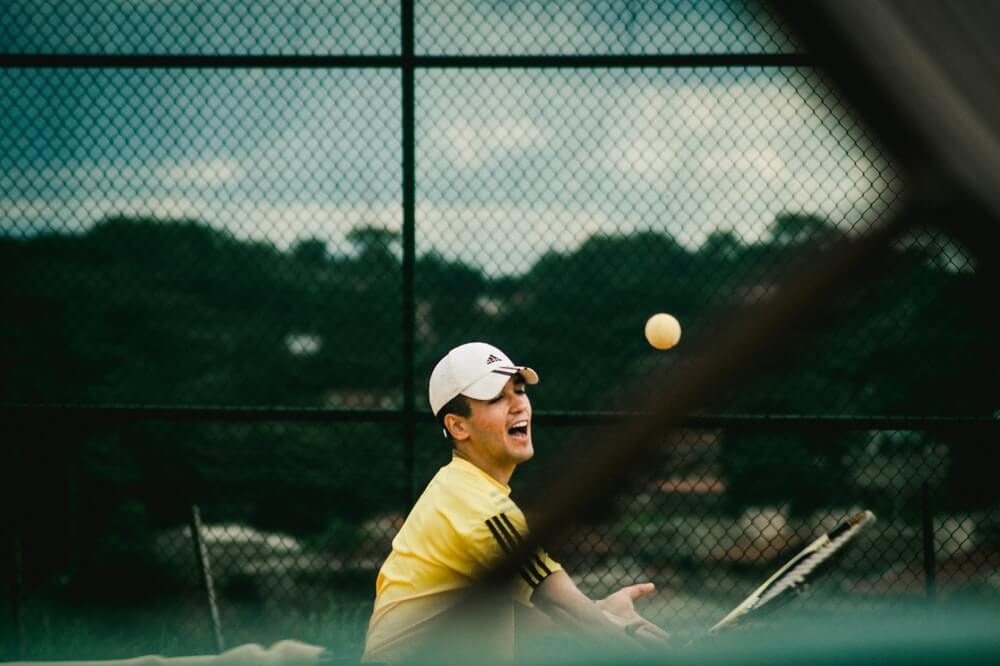Tennis Court Fencing: The Ins and Outs

People often ask whether it is necessary to erect a fence around a tennis court. A quick answer is that it makes sense to ensure that a tennis game does not interfere with passers-by or people on adjacent properties.
While adding the cost of a fence to the construction cost of a tennis court may seem daunting, it is worth including in your budget planning. In this article, we’ll cover some general information and considerations which may influence your decision.
Do I Need Tennis Court Fencing?
There are several reasons why it is essential to have tennis court fencing. At a basic level, a fence around the court helps ensure that the balls remain available to the players, and having more control over the movements of the balls helps the flow of the game. Just imagine the frustration of a stop-start game caused by continuous searching for balls in gardens around the court or across the road if they bounce over the property’s boundaries.
While a powerfully served tennis ball is arguably not as dangerous as a rogue cricket ball that sails into a packed crowd, it can cause damage to property or injury to people if allowed to travel beyond the boundaries of a tennis court. For this reason, a tennis court fence should be high enough to prevent such inconvenience and potential accidents.
Different Types of Tennis Court Fencing
Several types of tennis court fencing are available. In selecting the correct type of fencing for your tennis court, the first consideration should be whether it is strong enough to withstand the regular pounding of fast-travelling tennis balls.
But, the fencing should also survive the onslaught of adult tennis players who smash into them from time to time – and don’t forget the need for fences to remain standing in severe weather conditions.
Chain Mesh Fence
A chain mesh fence (also referred to as a chain-link or wire-mesh fence) is a type of woven fence often made from galvanized steel wire. The wires are bent into a diamond pattern and are interwoven vertically and into a zig-zag pattern.
This type of fencing is common across Australia, and it is also one of the cheapest options available.
Cable or Pipe Railings
Cable railings, or wire rope railings, are rails that use horizontal or vertical cables for infill. The cables or wire ropes are attached to a pipe structure that runs vertically and horizontally to form a strong foundation for the railings.
However, this is not as secure as a chain mesh fence, and due to the rigid nature of the tightly fastened cables or wires, a player wouldn’t want to smash into the cables accidentally.
Soft Fences
Soft fencing is another option. Usually applied as a windscreen stretched between posts rails or synthetic cord netting fastened similarly, this type of fencing is easy to repair. If this is what you prefer, be sure to buy material that allows for some wind flow.
It may be worth designing aesthetically-pleasing soft fencing that can be drawn back like a curtain to offer open views of the court and surrounding gardens or other views when the court is not in use.
What Type of Tennis Court Fencing Should I Get?
If you are uncertain what type of fencing to invest in for your tennis court, consider the following factors:
Strength and Durability
Fencing represents a significant portion of the total cost of a tennis court. While soft fencing may sound appealing, it is not as strong as chain link fencing. Chain link fencing or cable railings will do the job for many years to come.
Visibility
Regardless of whether you intend to use your tennis court for family recreation or competitions, visibility usually is an important consideration. For this reason, chain link fencing or cable railings are popular options.
Construction time
When people set out to erect a fence around their tennis court, they don’t want to waste time and money on long, drawn-out processes. Chain link fencing is arguably the quickest and easiest to erect and offers the most value for money.
Flexibility
Consider for a moment how players often run into tennis court fences when they attempt to play that ‘magical’ shot from the side or back of the court. Inflexible fences may cause unnecessary injury to a fast-moving or stumbling player – so choosing a flexible fence such as a chain-link type makes good sense.
How High Should My Fences Be?
As mentioned, most Australian tennis court fencing comprises chain mesh secured to metal poles. If this is your fencing of choice, you will need to consider the height, colour, and number of rail. In Australia, a popular choice is black powder-coated posts and rails with black PVC-coated chain wire mesh.
A typical height of a tennis court fence is between 3 meters and 3.6 meters.
How Much Does Tennis Court Fencing Cost?
When you commit to erecting a tennis court fence, it would be best to use the services of a licensed contractor with good reviews. Work with them to ensure a good planning process.
The cost of erecting a chain-link type fencing of between 3 meters and 3,6 meters may amount to between $12,000 and $20,000 but bear in mind that several factors could impact the price.
For more information about cost, feel free to get in touch and our team of fencing experts will be happy to provide you with the advice you need.
TFR Construction – Your Partner in Fencing
TFR Construction is Melbourne’s expert in earthworks, site prep, retaining walls, and fencing.
We design, customise and build sports courts for your home or community facility. If you are thinking about constructing a tennis court, read our blog 6 Things to Consider When Building Your Tennis Court for some tips and other essential information.
Get in touch with us if you have any questions or to schedule a no-obligation consultation. We would love to have a conversation with you to understand your needs.
Recent Posts
A Parcel for the Picking – Things to Consider When Buying Land for Your Home
Selecting the proper parcel of land might be challenging but approaching the task with the correct knowledge makes it worthwhile.
Stone Landscaping: Adding Statement Stone and Boulders to Your Landscape
Stone landscaping is low maintenance, sustainable, and extremely versatile. Here is a realistic view of the main pros and cons of stone landscaping.
5 Ways to Beautify Your Sleeper Retaining Walls
In this blog post, we examine how you can combine looks and function with the latest designs of retaining walls available today.
How Sleeper Retaining Walls Can Help with Property Water Drainage Systems
We take a closer look at why retaining walls can be a fantastic solution for redirecting water around the house and protecting your foundation.
What Is a Commercial Contractor?
Contractors who work on commercial buildings have the know-how, expertise, and certifications to handle commercial construction work. But what exactly is a commercial contractor, and do you need one for your next project? Read on to find out if a commercial contractor is right for you.
Recent Posts
A Parcel for the Picking – Things to Consider When Buying Land for Your Home
Selecting the proper parcel of land might be challenging but approaching the task with the correct knowledge makes it worthwhile.
Stone Landscaping: Adding Statement Stone and Boulders to Your Landscape
Stone landscaping is low maintenance, sustainable, and extremely versatile. Here is a realistic view of the main pros and cons of stone landscaping.
5 Ways to Beautify Your Sleeper Retaining Walls
In this blog post, we examine how you can combine looks and function with the latest designs of retaining walls available today.
How Sleeper Retaining Walls Can Help with Property Water Drainage Systems
We take a closer look at why retaining walls can be a fantastic solution for redirecting water around the house and protecting your foundation.
What Is a Commercial Contractor?
Contractors who work on commercial buildings have the know-how, expertise, and certifications to handle commercial construction work. But what exactly is a commercial contractor, and do you need one for your next project? Read on to find out if a commercial contractor is right for you.





